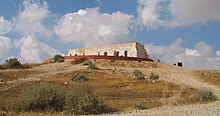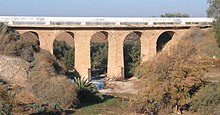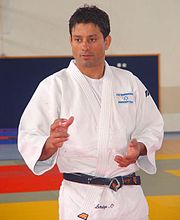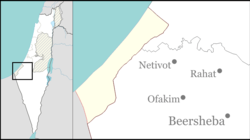Ofakim
Ofaqim
אוֹפָקִים / אֳפָקִים افقيم | |
|---|---|
 | |
| Coordinates:31°19′N34°37′E/ 31.317°N 34.617°E | |
| Country | |
| District | Southern |
| Founded | 19 April 1955 |
| Government | |
| • Mayor | Yitzhak Danino |
| Area | |
| • Total | 10,273dunams(10.273 km2or 3.966 sq mi) |
| Population (2022)[1] | |
| • Total | 35,506 |
| • Density | 3,500/km2(9,000/sq mi) |
| Name meaning | Horizons |
| Website | http://www.ofaqim.muni.il |
Ofakim(Hebrew:אֳפָקִיםʾŎfāqīm,or אוֹפָקִיםʾŌfāqīm,lit."horizons" ) is a city in theSouthern DistrictofIsrael,20 kilometers (12.4 mi) west ofBeersheba.It achieved municipal status in 1955. It has an area of 10,000 dunams (~3.9 sq mi; 10 km2). In 2022, it had a population of 35,506.[1]
Established as adevelopment townin 1955, Ofakim was for many years a major textile manufacturing center. Outsourcing of textile manufacturing outside Israel caused economic stagnation, and Ofakim suffered high poverty and unemployment rates for many years. Since then, new factories have moved in, and the city is currently undergoing major development. Ofakim was the scene of fighting betweenHamasFighters who infiltrated the city and Israeli forces in a stand-off during the2023 Israel–Hamas war;theIDFcleared the city of Hamas Fighters the following day.[2]
History
[edit]
Prior to 1948, the area was known asKhirbat Futais(Arabic:خربة فطيس), aBedouinhamlet populated by members ofAl-Qadiratclan ofAl-Tiyahatribe, located along "Wadi Futeis", a seasonal river that drains intowadi Gaza.The hamlet consisted of several mud houses, and the Bedouin residents were engaged in growing wheat, barley, and melon as well as raising sheep and goats.[3]The hamlet was located alongBeersheba-Gazahighway, a strategic location in land of Bedouin tribes whose inter-tribal clashes were a source of worry, promptedOttomansto build a military fort nearby, thePatish (Futais) fort.By mid-July, duringthe 1948 War(Operation An-Far), the village fell to theIDF,and the localBedouinfled toAl-Muharraqa,from which they were expelled toGaza Strip.[4]The abandoned Bedouin village was destroyed by the IDF in September or October 1948 for reasons that were described as "military".[5]
Ofakim was established in 1955 as an urban center for the rural communities in the area adjacent to the Ottoman fort and on the site of Khirbat Futais.[6][7]The first inhabitants were immigrants fromMoroccoandTunisia.The population in 1955 was about 600. The inhabitants initially lived in huts and tin shacks, but the construction of permanent housing proceeded rapidly, and the construction industry was the main source of income during the early years. In late 1956, after Jewish refugees expelled fromEgyptfollowing theSuez Crisisarrived in Israel, 150 Egyptian-Jewish immigrant families, including someKaraite Jews,came to Ofakim. In the following years, 170 Jewish families fromIranarrived, as did additional immigrants fromIndiaandRomania.In 1958, Ofakim was grantedlocal councilstatus.
In the late 1950s, the construction industry was still the main employer, and some residents also worked in agriculture nearby, but industry also began to be established in Ofakim, starting with a diamond polishing plant, followed by two textile factories that opened in 1959. At the same time, the town's streets were paved, public parks were established, and schools were founded. In 1961, the population was 4,600.
As in otherdevelopment towns,the industrial sector historically played an important part in Ofakim's economy. In 1972, 32% of the salaried workers (754 people) were in this sector, and in 1983—924 people (23%). During this period, the textile industry grew to dominate Ofakim's economy. Numerous textile plants were set up, and the industry employed by far the most workers, ranging from 72% (1982–83) to 82% (1972). The Of–Ar (short for Ofakim–Argentina) textile factory was a major employer.[8]In 1983, the population had grown to 12,600.
Ofakim's economy declined after Israeli textile manufacturers began closing their factories in Israel to move their production to other countries with lower labor costs, mainly in Southwest Asia, and toEgyptandJordanafter Israel signed peace treaties with those two countries. Starting in the mid-1980s, the city'stextile millsbegan to shut down, with the last one closing in 1995, rendering much of the population unemployed. In the early 1990s, during the mass migration of Jews from the former Soviet Union to Israel, more than 7,000 Soviet immigrants arrived in Ofakim, and were provided with heavily subsidized housing. This fueled further competition for jobs, and due to the fact that Soviet immigrants were typically better educated than the mainly unskilled or semi-skilled veteran population, they were better able to get the few jobs available. The city also absorbed immigrants from Ethiopia during this time. A few more plants moved into the city in the 1990s, including an electronics factory in 1996, but unemployment remained high.[9]Ofakim gained a reputation as an economically depressed city in Israel.
In 1997, it had the highest unemployment rate in Israel, at 15.3%.[10]It also had the highest unemployment rate in 2004, at slightly over 14%.[11]In 2008,Haaretzreported: "Nearly one-third of the inhabitants are supported by the welfare department and hundreds of families receive aid, including food, from non-profit organizations. Many of the inhabitants in their 50s and 60s have been dreaming of fleeing Ofakim since they were 20. When they retire, they leave."[12]
In the 2007, the Israeli Interior Ministry dismissed Ofakim mayor Avi Asaraf and his entire city council from their posts for failing to implement a recovery plan for Ofakim.[13]Zvika Greengoldbecame the new mayor.
Throughout the 2000s and 2010s, Ofakim gradually saw improvements in its economy. Tax incentives were given to open new factories in Ofakim, and a branch of MATI, an organization that supports small businesses, was opened. The high-tech industry also entered Ofakim. The city is currently undergoing a series of major development projects.
Ofakim was infiltrated by Palestinian forces on 7 October during the2023 Hamas-led attack on Israel.[14]On October 8, 2023, theIDFretook the city.[2]About 50 Israelis, including six police, were killed in the attack.[15]
Demographics
[edit]
In 2010, about one-fifth of the residents wereultra-Orthodoxand one third were immigrants from the former Soviet Union. Most of the rest were members and descendants of the founding generation of the immigrants who arrived in the town in the 1950s and 1960s. In addition, there are small communities ofEthiopian Jewsand Palestinians originally from theGaza Stripwho were resettled in Israel after collaborating with Israeli authorities.[6][7]
According to theCentral Bureau of Statistics,Ofakim had a population of 30,662 in 2019, and the population is growing at a rate of 1.4% a year. The percentage of the share of theArab Palestinianpopulation of Ofakim is very small and about 0.7%.[1]
Economy
[edit]
In 2013, about 40% of Ofakim's residents worked in the city. There were about 20 factories in Ofakim on 2,000dunamsof land. Some residents also work in high-tech.[16]
Education
[edit]In 2001, there were 21 schools and 4,704 students in the city – 13 elementary schools (3,079 students), and 8 high schools (1,625 students). 43.3% of 12th grade students were entitled to a matriculation certificate.
Sports
[edit]One of Israel's 14 tennis centers is located in Ofakim.[17]It opened in 1990 and has six courts. The city also has a soccer stadium. The Nahal Shomriyacyclingroute around Ofakim was inaugurated in 2010. The 60-centimeter-wide single route winds through 1,500 dunams (approx 375 acres) in Ofakim Forest, passing through Nahal Shomriya and Nahal Patish, and looping around eight localmoshavim.[18]
Transportation
[edit]
Ofakim is accessible byHighway 25and Route 241. Ofakim is connected to theTrans-Israel Highwayvia Highway 264.
TheAshkelon–Beersheba railway,a new railway line which connected Ofakim withTel AvivandBeersheba,was inaugurated in August 2015, which finally connected the railway line betweenAshkelonand Beersheba. TheOfakim railway stationwas opened on December 31, 2015.[19]The rail line connects Ofakim toBeershebain the Southeast, and toAshkelonand beyond toGreater Tel Avivin the Northwest.
Ben Gurion Airport,the closest major international airport, is located about 101km North from Ofakim, which can be accessed via a drive along theTrans-Israel Highway.
Urban development plans
[edit]
The city has begun to develop from 2015 onward after years of stagnation. Thousands of new housing units, commercial and employment centers, and a youth center which included a cinema were built.Ofakim Railway Stationwas completed in December 2015 with a car park for 1,000 cars.[12]Next to the train station, a new neighborhood specially designed to have affordable prices for young people, is being built as part of the "Noah Initiative", which was started by activists fromTel Aviv.[20][21]
In 2017, a new agreement was signed to build 14,436 housing units in four new neighborhoods and one established neighborhood, which will greatly increase the city's population. In addition, the agreement stipulated the development of an industrial zone in southern Ofakim, increased funding for infrastructure and urban renewal projects, and the construction of a new road between Ofakim andRamon Airport.The plan aims to double the city's population.[22][23]High-rise construction of buildings up to 13 stories is also planned.
Notable people
[edit]
- Shimshon Pincus(c. 1944–2001), rabbi
- Oren Smadja(born 1970), Olympic judoka
- Robert Tiviaev(born 1961), former Knesset member
References
[edit]- ^abc"Regional Statistics".Israel Central Bureau of Statistics.Retrieved21 March2024.
- ^abHasson, Nir (8 October 2023)."The Israeli Town of Ofakim Has Been Cleared of Hamas Fighters but the Blood and Shock Remain".Haaretz.Archivedfrom the original on 8 October 2023.Retrieved9 October2023.
- ^Dabbagh, Mustafa Murad. “Futeis (Village) (فطيس (قرية)).” Essay. In Our Country Palestine (بلادنا فلسطين) 1, 2st ed. Vol. 1. Beirut, 1966https://www.palestinapedia.net/فطيس-قرية/.
- ^Aweili, Muhammad Abu. “The Negev: Meeting with Haj Abu Mahir Abu Ataya from Al-Tahiya Tribe!! (النقب: لقاء مع الحاج ابو ماهر ابو عطايا من قبيله التياها!!).” ديار النقب, April 26, 2015.http://deyaralnagab.net/print.php?content=4&id=230.
- ^Morris, B.(2004).The Birth of the Palestinian Refugee Problem Revisited.Cambridge University Press. p. 355.ISBN978-0-521-00967-6.
- ^ab"Go south, young men (and women)".Haaretz.
- ^ab"New horizons for Ofakim".Haaretz.
- ^Schwarz, Dafna (2009). "Industrialization Attempts in Three Development Towns: Ofakim, Migdal HaEmek and Ma'alot". In Halamish, Aviva; Meir-Glitzenstein, Esther; Tzameret, Zvi (eds.).The Development Towns.Idan Series Vol. 24 (in Hebrew). Yad Yitzhak Ben Zvi. pp. 160–162.ISBN978-965-217-298-3.
- ^"Archives".Los Angeles Times.
- ^"Peak 145,600 Job Seekers in July - Globes".18 August 1997.
- ^"Unemployment falls, but do statistics lie?".Haaretz.
- ^abNew Horizons for Ofakim
- ^"Ofakim Mayor, City Council Dismissed for Failing to Implement Recovery Plan".The Jerusalem Post.August 29, 2007.RetrievedApril 16,2019.
- ^Lidor, Canaan (October 7, 2023)."Outside Ofakim, anguished parents seek signs of life from kids stranded in battle zone: Many young partygoers attending outdoor raves wound up in areas overrun by Hamas; some managed to send messages to parents, who rushed south laden with heavy hopes and fears".Times of Israel.RetrievedOctober 7,2023.
- ^Goldman, Adam; Koplewitz, Gal (26 October 2023)."Alone and Outgunned, Israeli Police Fought Hamas From House to House".
- ^"Ofakim, Israel | Nefesh B'Nefesh".
- ^Tennis doubles coexistence program
- ^KKL (February 22, 2010)."Riding and Building New Ofakim - Shomriya Cycling Route".The Jerusalem Post.RetrievedApril 16,2019.
- ^"Next stop: Ofakim"(in Hebrew). Arutz Sheva.Retrieved11 January2016.
- ^Tress, Luke (May 11, 2016)."Building anew in the Negev".The Times of Israel.RetrievedApril 16,2019.
- ^"מעריב תגיות | אופקים".
- ^"The New Ofakim Pact | Jewish Federation of Greater MetroWest NJ".Archived fromthe originalon 2017-08-25.Retrieved2017-08-25.
- ^"Agreement for 14,000 Housing Units Just Signed".Globes.May 29, 2017.RetrievedApril 16,2019.
External links
[edit]- Weaving community: Labour in Ofakim
- Works of communal art
- Survey of Western Palestine, Map 24:IAA,Wikimedia commons




